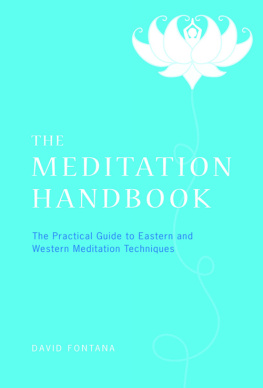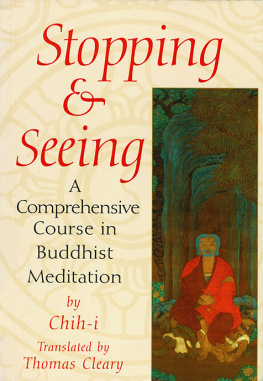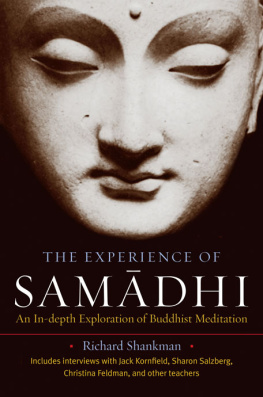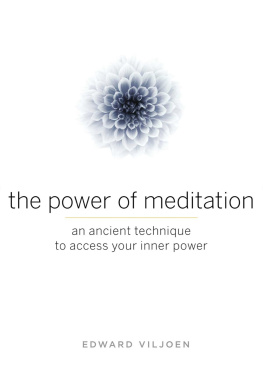
First published in 1998 by
SAMUEL WEISER, INC,
P.O. Box 612
York Beach, ME 03910-0612
Copyright 1998 William S. Bodri and Lee Shu-Mei
All rights reserved. No part of this publication may be reproduced or transmitted in any form or by any means, electronic or mechanical, including photocopying, recording, or by any information storage and retrieval system, without permission in writing from Samuel Weiser, Inc. Reviewers may quote brief passages.
Library of Congress Cataloging-in-Publication Data Bodri, William.
Twenty-five doors to meditation : a handbook for entering samadhi / William Bodri, Lee Shu-Mei.
p.cm.
Includes bibliographical references and index.
ISBN 1-57863-035-5 (pbk. : alk. paper)
1. MeditationBuddhism. I. Shu-Mei, Lee. II. Title.
BQ5612.B63 1998
294.34435dc21 97-51639
CIP
BJ
Typeset in 10.5 point Bembo
Printed in the United States of America
04 03 02 01 99 98
10 9 8 7 6 5 4 3 2 1
The paper used in this publication meets all the minimum requirements of the American National Standard for Permanence of Paper for Printed Library Materials Z39.481984.
www.redwheelweiser.com
www.redwheelweiser.com/newsletter
T o Mahakashyapa, who patiently waits, and to Rahula, Pindola, and Kundupada.
T o all the world's students who wish to cultivate, and who ardently seek the path to enlightenment.
Contents
Appendices
List of Illustrations
Introduction
T he purpose of this book is to introduce a wide variety of cultivation techniques to people who are searching for an appropriate spiritual practice. From the wide selection of techniques within, there are sure to be one or two methods which will interest any aspiring practitioner. Thus, any of these techniques can serve as the initial basis of spiritual practice.
The very first requirement of the cultivation path is to accumulate merit, for without merit it's impossible to succeed at the task of self-realization. But to succeed in enlightenment, you must also devote yourself to some form of spiritual practice, for otherwise you can't possibly attain Tao. The formula for progress in spiritual cultivation, which is valid for all other forms of endeavor as well, is Method + Effort + Time + Experience = Result. Thus you can expect the positive results of self-realization only after you put time and effort into following a proper cultivation technique (sadhana).
From your familiarity and experiences with an initial form of meditation practice, your understanding of cultivation principles will naturally grow, and from this progressive increase in wisdom and experience, your practice can be adjusted accordingly. In this way, matching experience with wisdom and theory, over time you make tremendous progress on the cultivation path. So with effort, experience, time, and practice you will definitely achieve substantial spiritual results.
It's often said that there are 84,000 different afflictions in one moment of the mind, and so there are also 84,000 various methods of cultivation practice, called dharma doors, that you can use to appropriately address these vastly different afflictions. The biggest problem in our lives is that these mental afflictions continually arise and give us no peace, thus blocking the path to attainment. Hence all the genuine cultivation methods in existence are aimed at quieting your thoughts, and when thoughts stop we attain a state of mental stillness or cessation called samadhi.
Samadhi is not a state of mental dullness or torpor, for within samadhi your mind remains clear, open and aware. It's an experiential realm where clear awareness and mental quiet are conjoined, for within samadhi the mind experiences such one-pointed concentration that the busy extraneous thoughts which normally bother us totally drop away. This is the initial stage on the path to spiritual development: a state of mental quiet within which our miscellaneous random thoughts seem to disappear. Sometimes we call this state of quiet emptiness, which is just a synonym for the absence of our discriminative monkey mind.
The samadhi of mental quiet marks just the very beginning stages of spiritual cultivation, for the ultimate attainment of self-realization requires that we develop transcendental wisdom as well. Transcendental wisdom, or prajna, is that discriminative but completely nonintellectual awareness that empowers us to perceive the true nature of the mind. Samadhi is just a stage of quiet and calm: it's still a phenomenal realm even though we say it's empty. When you attain samadhi, however, this emptiness of normal mentation allows you to realize how to detach from clinging to your mental experiences, and this is the necessary lesson we need to learn so that we can use our wisdom to turn around and perceive enlightenment.
The cessational aspect of samadhi is also important because it's through samadhi that we can purify and transform our physical bodies, and that's when all our spiritual powers and kung-fu (mind-body attainments) come out. On the spiritual path, both these aspects must be masteredwe must purify both our bodies and minds in order to reach the highest levels of attainment. But ultimately, prajna-transcendental wisdom is the factor we must rely upon for identifying and learning the enlightenment way. Without prajna-wisdom, you cannot awaken to enlightenment. Prajna-wisdom enables you to recognize the true mind.
Now, if people start practicing a particular cultivation method but don't understand the principles involved, they're likely to get lost on the path of spiritual cultivation. Unless one's beliefs are based on wisdom, practice without understanding is equivalent to being superstitious. Hence developing prajna-transcendental wisdom is all important, and to cultivate self-realization everyone must develop samadhi since samadhi is the means by which we realize our prajna.
In other words, samadhi is the pathway to cultivating spiritual wisdom; from within a quiet mind, you can develop the spiritual wisdom that lets you recognize the true mind and succeed on the path of cultivation. You can perform all the religious ceremonies you like and attend all sorts of spiritual services, perform a wide variety of meritorious acts, exercise your intellect in all sorts of ways, strictly follow religious injunctions and codes of conduct, and even memorize reams of religious dogma. These can all be extremely worthwhile activities, but no matter what you do, there is no such thing as true spiritual progress unless you attain samadhi and prajna. All these other activities are just expedient means designed to guide you to this goal.
Some methods of arriving at samadhi begin with the mundane realm of reality and apply various techniques to arrive at a state where discriminative thought disappears, where the mind is calm and stillwhat we call empty or void. Some methods begin by cultivating this emptiness directly. Some cultivation practices involve form; other methods involve formless doors to samadhi. Sometimes a method will involve adding burdens to the mind in order to get rid of mental chaos, other methods will involve subtracting burdens to arrive at an absence of internal mental chatter. Certain methods will involve cultivating one's jing (seminal essence) or chi (vital energy or prana), while other methods will involve cultivating one's shen (spirit). Some methods will investigate the insubstantial nature of worldly appearances, while others will abandon phenomena altogether and work solely on investigating the formless mind which is able to perceive phenomena.
There are cultivation methods which focus on elements within space and time, and methods which focus on elements outside of space and time. Some cultivation methods deal with tracing the senses back to their ultimate source, and other methods focus on mastering various realms of consciousness. But all these different cultivation methods, if they are genuine spiritual techniques, are equally aimed at giving rise to samadhi, and then to transcendental spiritual wisdom.
Next page








